© 2020 Dr Margaret Sheppard
Z.C.C. Sekgoa(English) Wedding - in lieu of “Wearing the Lomipi”
This wedding was held in the main kgotla where I lived, in October 1981 (the usual period of weddings.. It was held for a Z.C.C. couple who had been married several years previously (they were now in their 50's) by a Setswana wedding, and it was in lieu of the traditional “Wearing the Lomipi” as they were church members. They wished to complete their own wedding so that one of their sons could have his wish for a Sekgoa (English)wedding.See section on “Weddings” for a more detailed description.)
This wedding had started at the ZCC Church in Lobatse, where the bride wore a white dress and large white picture hat.The first part, which I did not attend, was held at her home in Kanye. Then on the Saturday it came to her husband's home. This part was exactly the same as all the Sekgoa weddings. At about 1.30 p.m. the husband was taken half way to the edge of the kgotla to meet his wife. She was being brought in procession from her kgotla. They both wore the usual Sekgoa. wedding clothes, he in a suit and she in her white dress and white picture hat. Both wore white gloves and were sheltered from the sun by umbrellas.
When they returned to his kgotla, the whole way the processions from both his home and hers, were singing the traditional wedding songs. The procession went first to the Headman's yard to "show the “new bride" to the senior lady of the kgotla -
After dancing around in the Headman's lolwapa, they then progressed to the husband's home (which was opposite). Here during the preparations for the wedding the grass had been cut in front of the yard, and a new Tswana house had been built, as well as a pole and tarpaulin construction for the bridal couple to sit under. The wedding continued in the usual way, the couple changing into "change" clothes during the course of the afternoon.
During the night a Z.C.C. service was held at this home. The format was exactly the same as for the other ZCC wedding. Throughout Saturday and Sunday beer was brought in the usual way -
The all-
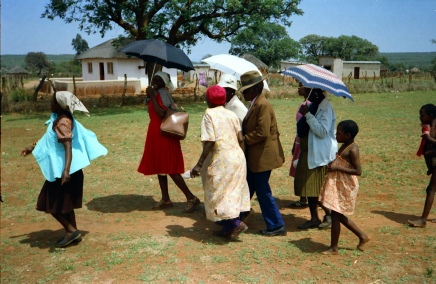

The bride being brought in procession by her kin to her husband’s kgotla
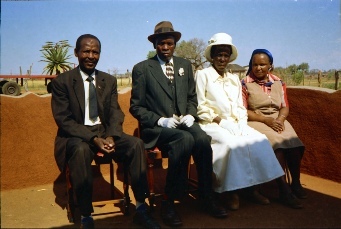
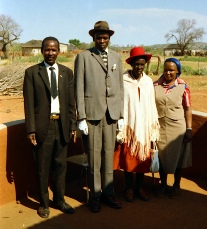
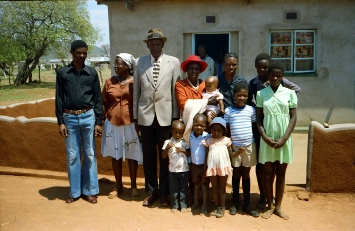
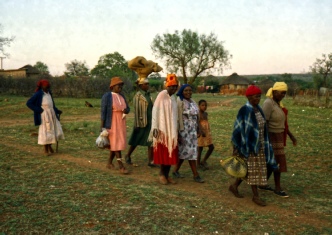
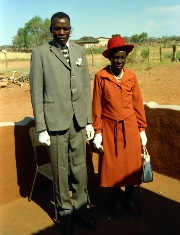
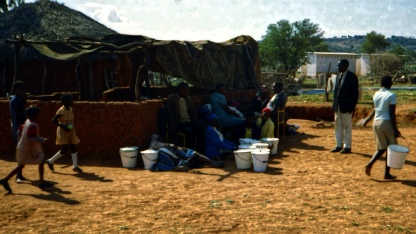
The bridal couple and attendants
“Change” outfits
The bridal couple with children and grandchildren
“Change” outfits
Some of the wedding beer (in white buckets) brought to welcome the bride
Bride being brought by her family. Woman in stripy blazer is carrying part of beast slaughtered at bride’s home for the wedding feast to notify Ancestors of the wedding.
It will be seen from the descriptions of these three serVices that there are many similarities between Z.C.C. practices (rituals) and those previously described in Part 2~ For example Z.C.C. greatly respect Badimo. Prophets frequently, although stating that their prophecies are from God, also say that they receive them from their Badimo. The Lekgonyanes and their Badimo are revered rather like the Badimo of the traditional Chiefs. Chiefs are also greatly respected, as was seen at the wedding in Lotlhakane when all the congregations which were visiting to celebrate the wedding went to greet the Chief. In the wedding for the old people the "new bride" was taken to the Headman's home to be formally "shown" to the senior lady. At Lotlhakane a collection was even made for the Chief and special dances and songs were performed for him.
Again there is a strong belief in boloi and the purification at the beginning of the service is to protect against baloi and boloi. In the same way that a traditional doctor washes all the family, so with the Z.C.C. practice where all the family will be called into the centre of the circle. Just as a traditional doctor may wear special beads to discover boloi and the position of buried boloi or to protect himself against its harmful effects, so also do Z.C.C. (as is seen in Volume 2) when some wore the “Scottish” costumes and carried little wooden axes and poles so that they would be able to "see" the boloi and be protected.